By Jim Davis - Florida Catholic
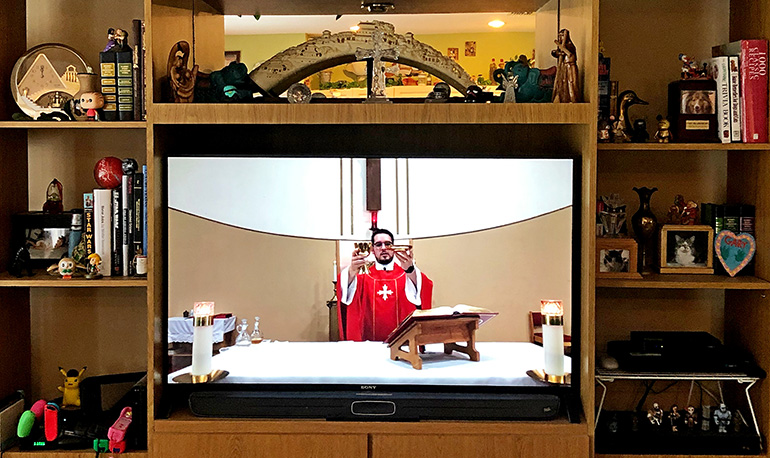
Photographer: COURTESY
Father Bryan Garcia says some parishioners at St. Bernadette Hollywood watch online Mass as families.
MIAMI | A recent Mass by Father Yamil Miranda had a deceptively normal look: celebrant, cantor, lector, organist. At least, until a deacon wafted incense over not only the priest and the altar, but toward a webcam.
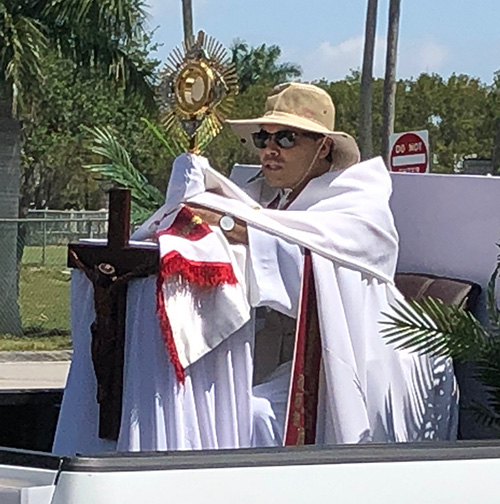
Photographer: COURTESY
Father Yamil Miranda of All Saints Church recently brought the consecrated host around the streets of Sunrise, with a parishioner livestreaming the procession with an iPhone.
Father Miranda then suggested that his viewers place some water in front of their monitors — then he blessed it through the camera.
"This pandemic has awakened the creativity in many of us," said Father Miranda, who said the Mass in the chapel at All Saints Church in Sunrise. "We've developed ways to reach someone who needs a healing word."
The COVID-19 quarantine has hampered priests' ability to minister as they learned in seminary. Yet with the new tools of social media, many are becoming skilled fishers of men by using a different kind of "net": the internet.
"This is a means of evangelization — not only reaching our parishioners, not only staying in our quarters, but reaching beyond," Father Miranda said.
Along with the familiar Facebook, YouTube and Instagram, priests are using:
- Zoom and Webex, video conferencing apps.
- WhatsApp, a messaging app sending text, photos, videos and voice recordings.
- Livestreaming, which can share video of an event online as it happens.
- Podcasting, an audio program allowing a priest or music group to record at length and save it on a church's website.
STEEP LEARNING CURVE
The rapid spread of the pandemic, plus the sudden closure of archdiocesan parishes, forced many priests to learn as they went.
On the first day of the closure order, Father Julio De Jesus improvised with his iPhone and two emergency lights sitting on columns.
"It got really hot," said the pastor of St. Benedict Church, Hialeah. "Later, some parishioners gave me LED lights."
He now does daily livestreams of Holy Hour and Mass, then has them archived on YouTube and Facebook. He also posts 30-second "admonition talks" on Facebook.
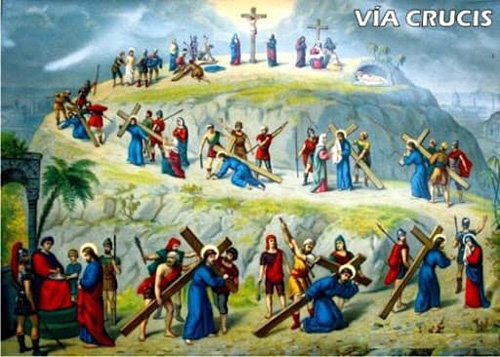
Photographer: COURTESY
A social media specialist makes original graphics for ministries of St. Boniface Church in Pembroke Pines.
In January, when Father Elvis Gonzalez came to St. Michael the Archangel Church in Miami, the parish had little on social media. He quickly changed that. Now St. Michael streams daily Mass on Facebook and YouTube, as well as its website. Father Gonzalez and retired Bishop Fernando Isern also do the Divine Mercy chaplet each Thursday.
Behind the scenes, St. Michael holds video conferences via Zoom and Webex with ministry leaders like those of religious education, Emmaus and the charismatic prayer group.
"The pandemic accelerated the steps," Father Gonzalez said. "When there's a need, you have to do it. There's no way to practice. You just do it."
To his surprise, virtual attendance has outstripped the physical. Between live viewership and those who watch later, about 3,000 watch Sunday Mass in Spanish, another 1,500-2,000 in English. That's twice as many as would have shown up at church, he said.
He's been gratified at feedback thus far. One parishioner sent a message: "Thank you for being present, for bringing Christ into our household."
Other priests were ready when the quarantine took effect. When Father Fernando Orejuela came to St. Boniface Church seven years ago, he launched several online initiatives.
The church's existing YouTube channel posts Masses, retreats, sometimes even funerals. Outreaches also include weekday rosaries and Divine Mercy chaplet, and podcasts by the church's music group, Heart & Soul. St. Boniface maintains links on Twitter and Instagram as well.
ALREADY DOING IT
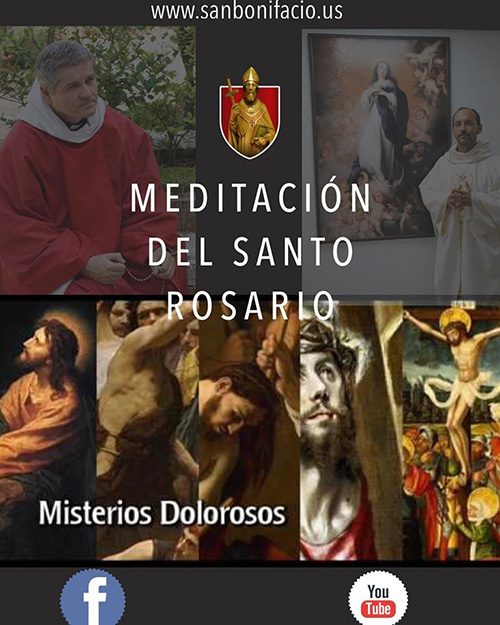
Photographer: COURTESY
A social media specialist makes original graphics for ministries of St. Boniface Church in Pembroke Pines.
Father Orejuela goes live on the church's Facebook page every Monday in cooperation with Radio Paz, to offer a weekly teaser about his theme for the coming weekend.
Newest feature on St. Boniface's website is 24-hour adoration with exposition of the Blessed Sacrament.
"It's easy to do, because we were already doing it," said Rosa E. Frometa, who manages the webpage for the Pembroke Pines-based church. "We were prepared for this."
The 70 lay ministries keep in constant touch through WhatsApp. "I look at 40 chats every day," Frometa said.
St. Boniface even has its own social media director, Geraldine Rincon. She constantly updates the church website, adding attention-getting graphics.
At St. Bernadette in Hollywood, it's the members who had to adjust. Father Bryan Garcia found some didn’t even know the church was online.
"A lot of people who were coming consistently weren't connected with social media," he said. "And some didn’t know we were doing this."
Personal phone calls by his office staff helped, and he said whole families now watch his daily Masses on Facebook Live. One woman said her husband, who hasn't attended church in years, has taken an interest in the homilies.
"It's a small but powerful moment of evangelization," Father Garcia said.
Now that they're on social media, many priests realize the reach they’ve achieved. They speak with amazement at people logging in from distant places like Spain and Germany, Colombia and Nigeria. Father Miranda said a nurse in Mexico thanked him for praying for medical workers.
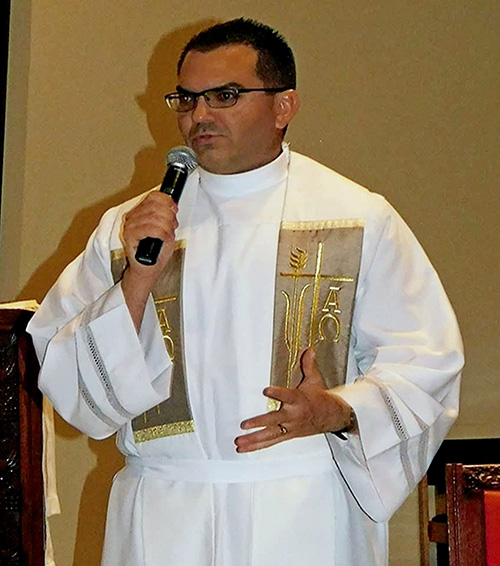
Photographer: COURTESY
Father Javier Barreto of Little Flower Church, Hollywood, says social media makes people pay more attention to the liturgy.
At Little Flower Parish in Hollywood, Father Javier Barreto posts music via the Adoremus ministry based in southwestern Broward County. Adoremus schedules music by singers around Latin America, then e-mails him a link, which he then shares online.
"To get these singers, I would be super-happy," Father Barreto said. "It's amazing what you can do today."
To his surprise, some people have learned more about adoration and the liturgy because of social media. "They say they used to go to Mass, then sit, then go home. Now, they have to put more effort into it. I didn’t expect that."
GOOD FOR PRIESTS, TOO
Priests are even using social media for personal enrichment. In mid-April, Father Gonzalez of St. Michael met via Zoom with 15 fellow graduates of St. Vincent De Paul Regional Seminary, praying, reminiscing and catching up. It was two years since they had last gathered, he said.
"It was wonderful, beautiful, sharing our graces and challenges and hopes," Father Gonzalez said. "Online has shortened a lot of distance."
He's using similar methods in his role as archdiocesan vocations director. In twice-weekly Zoom meetings, he talks and prays via Zoom with 54 young men in seminary formation sessions, talking with half of them each time. He added that they're continuing classes online. So the next generation of priests will be more comfortable with social media.
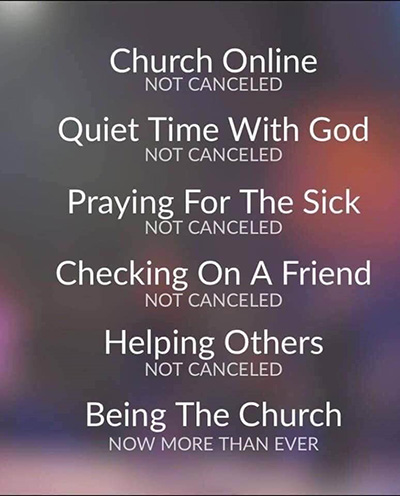
Photographer: Via Facebook
One of many messages and memes proliferating on social media during this coronavirus pandemic.
The technology does carry risks and downsides, the priests acknowledged. One is the loss of the sensate side of Catholic worship: the bells and incense, the water and oils, kneeling and praying together.
Virtual attendance is also an issue. If people don’t tune in, no one knows. If they watch a recorded Mass, they can skip to the parts they like. They can compare preaching styles of their pastor and others, even those out of state.
Priests, too, must cope with detachment from the people they're ministering to.
"I've preached to thousands, and it's sad that I have to talk to a camera," Father De Jesus of St. Benedict Church said. "But if the people are getting the message of salvation, that's what matters."
But the priests say the risk is offset by their new reach. Also, the technologies are becoming more affordable and understandable, they say.
"This isn't that hard," insisted Father Miranda of All Saints. "All you need is a laptop or an iPad and a Facebook page, and your willingness to celebrate Mass without a congregation. If you love the ministry, you'll do anything to reach your people."
And based on their experience, even media-savvy priests say that when the quarantine ends, people will likely return to church. Father Barreto said that more than 100 have actually complained they can't attend, even if they'd been taking church for granted.
"People are dying to receive the Eucharist and go to confession," Father Barreto said. "They're understanding more and valuing more."
Father De Jesus said he often tells people, "You can't baptize or marry or receive Eucharist online." But, he added, they don’t really need convincing. He cites parishioners' comments like: "I can't wait to come back to church and receive the host."
Said the priest: "Lent is over, and we went through fasting of what is most important — the Eucharist. Because of this pandemic, I see people fall in love more and more with the Eucharist."
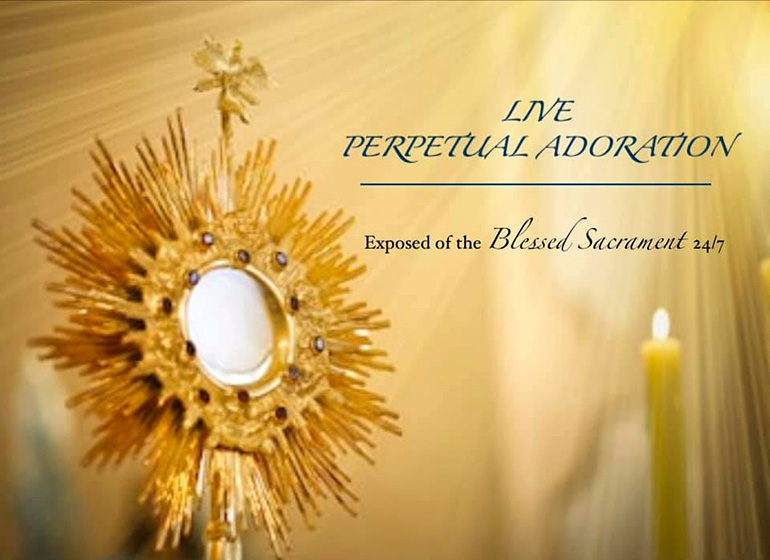
Photographer: COURTESY
A social media specialist makes original graphics for ministries of St. Boniface Church in Pembroke Pines.


Comments from readers